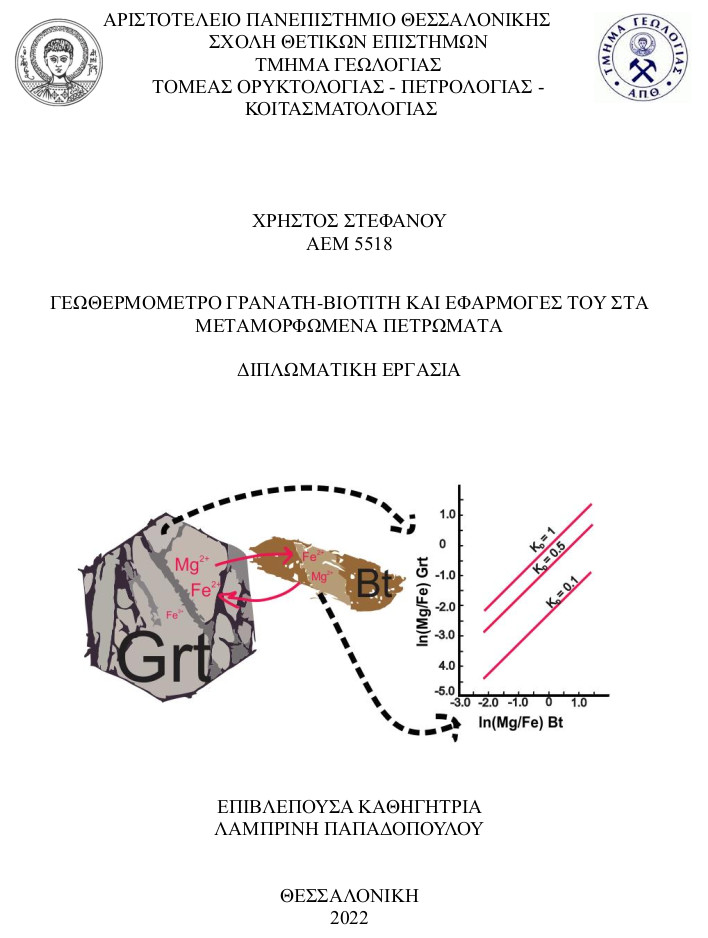
Γεωθερμόμετρο Γρανάτη-Βιοτίτη και εφαρμογές του στα Μεταμορφωμένα Πετρώματα = Garnet-biotite Geothermometer and its applications on metamorphic rocks.
Περίληψη
In the study of the geological history of a rock formation, the need to quantify the parameters that contributed to the transformative course of the formation arises. The inherent weakness of a qualitative petrological approach that is offered by tools such as index minerals and P-T phase diagrams can be overcome by geothermobarometry. An approach that focuses on the thermodynamic parameters of a formation and how they imprint on the structural elements of the rock, i.e.the minerals, through chemical and textural changes. When the thermodynamic equilibrium of a rock is disturbed, it’s structure on a microscopic level becomes more unstable, as the matter it’s made of decreases in the measure of order that defines it. Rock components with increased internal energy, usually ions, gain mobility that is described by the Gibbs free energy, move between the surfaces that separate the crystals that are in contact and become accepted in corresponding positions in neighboring crystals. This way crystals, solid solutions in contact are formed. These crystals represent a chemical reaction. There are categories of reactions sensitive to the change in temperature and others sensitive to the change in pressure. A mineral assemblage of garnet and biotite, where intercrystalline exchange of ions takes place, is an ideal chemical reaction to determine the thermal course of a rock as it stable in a wide range of temperatures. A defining parameter in this case is the equilibrium constant that is determined by the concentration of iron and magnesium ions at the point of equilibrium. This parameter can be determined in vitro and can be used in the formation of an equation/thermometer that is applied to chemical analysis data of a rock.
Πλήρες Κείμενο:
PDFΑναφορές
Nesse W.D. 2017. Introduction to Mineralogy, Third Edition, Oxford University Press, p. 495.
Bucher, K., & Grapes, R. (2011). Petrogenesis of metamorphic rocks. Springer-Verlag Berlin Heidelberg, p. 428.
Πολυζάκης A. 2017. Θερμοδυναμική και προχωρημένη Θερμοδυναμική. Πτολεμαϊδα, Power Heat Cool.
Misra K.C. 2012. Introduction to Geochemistry. Wiley-Blackwell.
Spear F. S. 1993. Metamorphic Phase Equilibria and Pressure-Temperature-Time Paths. Mineralogical Society of America, Monograph, p.799.
Balluffi R.W., Allen S.M., Carter W.C. 2005, Kinetics of Materials. John Wiley & Sons, Inc.
Bento dos Santos Τ.M., Tassinaric C.C.G., Fonseca P.E. 2014. Garnet-biotite diffusion mechanisms in complex high-grade orogenic belts: Understanding and constraining petrological cooling rates in granulites from Ribeira Fold Belt (SE Brazil). Journal of South American Earth Sciences, 56, 128-138.
Wu C-M, Cheng B-H. 2006. Valid garnet–biotite (GB) geothermometry and garnet–aluminum silicate–plagioclase–quartz (GASP) geobarometry in metapelitic rocks. Lithos, 89, 1-23.
Lanari P and Engi M. 2017. Local Bulk Composition Effects on Metamorphic Mineral Assemblages. Reviews in Mineralogy & Geochemistry, Vol. 83, pp. 55–102.
Li D., Wang G.H., Bons P.D., Zhao Z.B., , Du J. X., Wang S. L., Yuan G. L., Liang X., Zhang L., Li C., Fang D. R., Tang Y., Hu Y. L., Fu Y. Z. 2020. Subduction Reversal in a Divergent Double Subduction Zone Drives the Exhumation of Southern Qiangtang Blueschist‐Bearing Mélange, Central Tibet. Tectonics, doi:10.1029/2019TC006051
Likhanov I., Nozhkin A., Vladimir R., Vital'evna Khiller V. 2015. P–T evolution of ultrahigh temperature metamorphism: Evidence for a Late Paleoproterozoic intraplate extension at the southwestern margin of the Siberian Craton. Doklady Earth Sciences, 465(1), 1139-1142.
Likhanov I. 2019. Mass-transfer and differential element mobility in metapelites during multistage metamorphism of the Yenisey Ridge, Siberia. Geological Society London Special Publications, 478, 89-115.
Lewerentz A., Harlov D.E., Scherstén A., Whitehouse M.J. 2019. Baddeleyite formation in zircon by Ca-bearing fluids in silica-saturated systems in nature and experiment: resetting of the U–Pb geochronometer. Contributions to Mineralogy and Petrology, 174, 8, article id. 64, 25 pp.
Παζάρας Γ. 2016. Πετρογραφική μελέτη μεταπηλίτη από την Νήσο Αμμουλιανή, Ν. Χαλκιδικής, Διπλωματική εργασία, Τμήμα Γεωλογίας, Α.Π.Θ., σ. 67.
Ιστοχώροι
https://geologyistheway.com/minerals
https://serc.carleton.edu/research_education/equilibria
https://commons.wikimedia.org/wiki/File:Clockwise_ptt_path.png
https://www.alexstrekeisen.it/english/meta/index.php
https://www.earth.ox.ac.uk/~davewa/pt/pt04.html
https://www.doitpoms.ac.uk/tlplib/solid-solutions/olivine
https://www2.tulane.edu/~sanelson/eens212/thermodynamics&metamorphism.htm
Εισερχόμενη Αναφορά
- Δεν υπάρχουν προς το παρόν εισερχόμενες αναφορές.
